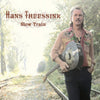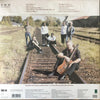



Hans Theessink - Slow Train (DMM)
Vocals, Guitar, Banjo, Mandolin, Mandoguitar, Harmonica – Hans Theessink [click here to see more vinyl featuring Hans Theessink]
Backing Vocals – Vusumuzi "Vusa" Ndlovu, Zibusiso "Blessings" Nkomo
Backing Vocals, Percussion – Dumisani "Ramadu" Moyo
Drums, Percussion – Harry Stampfer
Electric Bass, Double Bass – Erich Buchebner
Organ, Piano, Electric Piano [Wurlitzer], Harmonium [Pump Organ] – Roland Guggenbichler
Written by Hans Theessink (A1-3, A5-B5). B4 is translated and arranged by Hans Theessink
1 LP, standard sleeve
Original analog Master tape : YES
Direct Metal Mastering (DMM)
Heavy Press : 180g Premium Quality Vinyl
Record color : black
Speed : 33 RPM
Size : 12'’
Stereo
Studio (live studio recording)
Record Press : Pallas
Label : Pro-ject, Blue Groove
Original Label : Pro-ject, Blue Groove
Recorded by Thomas Löffler at Pinky's, Austria
Mixed by Peter Cebul at T-on, Austria
Produced by Hans Theessink and Milica Theessink
Mastered by Horst Pfaffelmayer & Boban Milunovic at Gold Chamber Mastering, Austria
Released in 2007
Tracks:
Side A:
- Slow Train
- Katrina
- God Created The World
- Thula Mama - Oh Mother Don't You Weep
- Love You Baby
Side B:
- Old Man Trouble
- Leaving At Daybreak
- May The Road
- Run On For A Long Time
Reviews:
“They call him the Eurobluesman, and he's one of the few Europeans to make a very convincing fist of the blues. At it for many years, he's recorded an excellent catalog of material, and this is no exception. There's plenty of space here, which is something that suits his very relaxed style, so laid-back that at times it seems as if he couldn't be more at home. But when you consider that one of his inspirations must be J.J. Cale, that's perhaps not too surprising. A deft instrumentalist, playing guitar, mandolin, harmonica, banjo, and mandoguitar, he uses the instruments sparingly and well, allowing his lovely, warm voice to dominate. There's backing, of course, but the arrangements are happily spare, and the African backing singers add a touch that's not so much exotic as just right, but remarkably more redolent of South Africa than the homes of the blues in West Africa. But never mind, it fits, just like everything on this very satisfying disc.” AllMusic Review by Chris Nickson
Direct Metal Mastering
In Direct Metal Mastering, the cutting lathe engraves the audio signal directly onto a copper-plated master disc, instead of engraving the groove into a lacquer-coated aluminum disc.
The direct metal mastering technology addresses the lacquer mastering technology's issue of pre-echoes during record play, caused by the cutting stylus unintentionally transferring some of the subsequent groove wall's impulse signal into the previous groove wall. In particular, a quiet passage followed by a loud sound often clearly revealed a faint pre-echo of the loud sound occurring 1.8 seconds ahead of time (the duration of one revolution at 33 rpm). This problem could also appear as post-echo, 1.8 seconds after a peak in volume.
Another improvement is noise reduction. The lacquer mastering method bears a higher risk of adding unwanted random noise to the recording, caused by the enclosure of small dust particles when spraying the silvering on the lacquer master, which is the necessary first step of the electroplating process for reproduction of the master disc. As the DMM master disc is already made of metal (copper), this step is not required, and its faults are avoided.
With the groove being cut straight into a metal foil, this removed a number of plating stages in the manufacturing process. This gave rise to more upper frequency levels and less surface noise. Additionally, groove pre-echo problems are significantly diminished. Bass is typically tight and well defined, even described as more accurate than the fat, mushy sound of lacquered vinyl pressings.
Ratings:
AllMusic : 4 / 5 ; Discogs : 4.46 / 5


